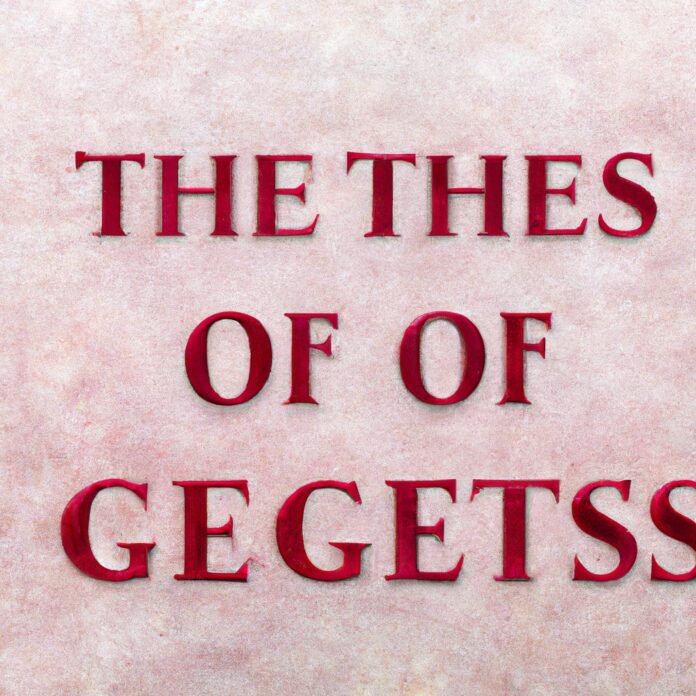The Age of Enlightenment was a period of intellectual revolution marked by a growing interest in the sciences and an exploration of new ideas. As part of this age, the concept of beauty was a major topic of discussion, and people began to study the power of beauty in a variety of ways. Beauty was no longer simply something to be appreciated on a superficial level and its impact on society became more and more pronounced. By exploring the intersection of science and vanity, this article will provide insight into the changing perceptions of beauty during this unique period of history.
I. A Glimpse at Enlightenment-Era Beauty
The Enlightenment-era marked an exciting time in beauty and fashion. Women were no longer bound by the strict rules and regulations of the previous century, allowing them to redefine what it meant to be beautiful. This newfound freedom opened up a world of possibilities.
Aesthetics of the time focused on femininity, artistry and sensuality. Particularly fashionable were:
- Rouge: Used primarily on the cheeks and lips to recreate the natural flush of youth.
- White Lead Paint: Applied to the face to give skin a “pearly appearance”.
- High Heels: Envied by women and worn to give a sensual look and feel.
The hair of the time was also interesting, with trends shifting between coiffures of tightly wound curls on the head to simple, loosely pulled-back styles. Women also accessorized their looks with feathers, lace, ribbons and gems. Long, flowing gowns were often paired with modest ankle-length boots, providing balance and a look of elegance.
Enlightenment-era beauty was all about experimentation and breaking away from convention. It served as a beacon of hope in a time of freedom and rebellion. It’s no wonder why it continues to influence fashion trends even today.
II. Defining Beauty: Science Meets Vanity
We often think of beauty as a purely subjective concept, and certainly our definitions vary greatly from one culture and individual to the next. However, recent studies have sought to quantifiably measure the elements of beauty and narrowed the gap between beauty and objectivity. Scientists and psychologists have long defined physical beauty with mere measurements, such as body size or facial symmetry. Now, new research from American and British universities is adding to these ideas by delving into the psychology of beauty, seeking to understand what makes something, or someone, attractive.
Cognitive vs. Aesthetic Appeal: One distinction that researchers have begun to explore is the difference between cognitive and aesthetic appeal. Cognitive appeal is based on the idea that attractiveness is more closely correlated with intelligence, education, and socioeconomic status. Aesthetic appeal is more based on physical characteristics and conventions of beauty. Studies have found that both are equally important when measuring ‘beauty.’
The Role of Symmetry: The science behind physical attractiveness also tends to focus on symmetry. Symmetry, which is defined as a balanced and proportionate set of features, has been linked to physical beauty. A study conducted in France indicated that, when given the option to select the most attractive face among a range of digitally manipulated photos with different levels of symmetry, nearly three-fourths chose the most symmetrical one, proving that symmetry is still a major criteria for beauty today.
- Cognitive appeal is based on intelligence, education, and socioeconomic status.
- Aesthetic appeal is based on physical characteristics and prevailing conventions of beauty.
- Symmetry is strongly linked to physical beauty.
III. Beauty Through the Lens of Reason
When we talk about beauty, we often think of it as something subjective, something indefinable that can’t be captured or described. But what if we looked at it differently – through the lens of reason? The beauty of reason is that it can tell us that regardless of what we find aesthetically pleasing, it is always based on the underlying logical rules and structures of reality.
We all have different interpretations of beauty, but by looking at it rigorously through reason, we can identify some commonalities that span different cultures and beliefs. We can perceive beauty not just through a pure aesthetic lens, but also one of rational order. There are a few key ways that one can spot the beauty of reason:
- Coherence: there is structure, harmony and order in the physical laws that allow us to exist in the world;
- Explanation: the scientific facts explain how the universe operates;
- Formulation: mathematics can be used to accurately describe phenomena, from the movement of planets around the sun, to the intricate details of quantum mechanics.
The beauty of reason is that it can provide us with a glimpse into the vastness of reality, beyond the constraints of our individual beliefs and biases. Everything from the mathematical equations used to study quantum mechanics to the rational laws that shape our beliefs can be perceived as beautiful in the eyes of those that appreciate their intricacies and complexity.
The appreciation of beauty through the lens of reason can open up a whole new world of discovery for those who seek out such knowledge. Through this perspective, one can come to appreciate the wonders of the universe and the fundamental structures that make it all possible.
IV. Redefining Society Through Beauty
The concept of beauty has long been a cornerstone of societal norms and standards. Over time, there is no doubt that public opinion and definitions of beauty have shifted. Now more than ever, people are striving to redefine the definition of beauty and break down damaging stereotypes in their pursuit of real self-expression.
Certain elements, such as facial features and body shape, used to be given a disproportionate level of importance when discussing beauty. But we are now beginning to recognize that beauty extends to far more than just physical attributes. Sensitivity, kindness, intelligence, strength, and resilience are all characteristics that we can consider beautiful.
Rather than being shackled by narrow definitions of beauty, we can choose to embrace and celebrate what makes us unique. Self-love is no longer a luxury, but a necessity. And by contributing to a culture that reflects real beauty and authenticity, we can help move towards greater inclusion and understanding.
- Be Celebrated for Your Uniqueness –
Discover and accept the parts of yourself that make you unique. Make no apologies for these parts and strive to make them a source of pride. - Support Style Diversity –
Supporting style diversity is more than embracing trends and fads – it’s about using fashion to express who you are and celebrating the styles of others. - Value Internal Attributes – Value yourself and be mindful of the internal attributes that define beauty: Strength, resilience, intelligence, and empathy.
V. The Legacy of Beauty in the Age of Enlightenment
During the Age of Enlightenment, Beauty saw a great resurgence in the artistic circles of Europe. The 18th century was an exciting time for the creative professions, with Science paving the way for new discoveries and ways of thinking, and Art providing the beauty and grandeur that personified this prosperous period.
- Rococo Style – This interior design movement flourished in Europe in the 18th century and laid out the foundations for a more graceful aesthetic. The rococo style was marked by its dedication to the embellishment of everyday objects, such as furniture and tableware.
- The Triumph of the Grandeur – Paintings of grandiose architecture, such as the baroque interiors of palaces and cathedrals, served to remind the viewer of the presence of opulence and grandeur that had been the hallmark of the period.
- The Development of Neoclassicism – This style of art was an attempt to bring a sense of order and beauty to Europe, and was inspired by the architecture of ancient Greece and Rome.
The Age of Enlightenment also gave birth to the idea of ‘primitivism’, which sought to bring a greater appreciation of nature to the public’s attention. Paintings such as Gainsborough’s Mr. and Mrs. Andrews (1748) depicted the countryside and its inhabitants in a romanticised manner, allowing viewers to forge an emotional connection with the natural world.
The beauty of this period of art and design continues to influence contemporary creative professionals. From the use of distressed materials, to the mix of obscure patterns and bold, vibrant colours – the influence of the Age of Enlightenment can still be seen in many of today’s interiors and works of art.
The Age of Enlightenment changed our views of beauty forever. By linking beauty to science and vanity, individuals now found themselves more empowered through their own self-awareness and understanding. By recognizing the intricate relationship between the physical and metaphysical, the Enlightenment marks a powerful moment in the history of beauty.

